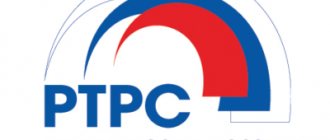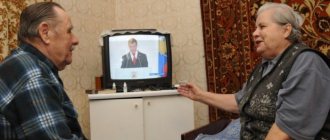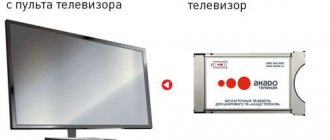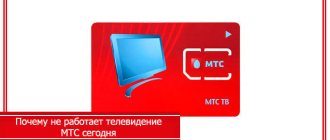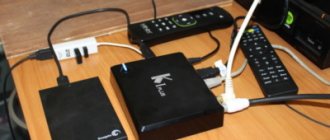Digital television of the Russian Federation is a set of services, including TV channels and radio stations operating in the DVB-T2 standard. According to the federal program, from 2009 to 2021, preparatory work was carried out related to the transition from analogue to digital broadcasting, which will be able to provide 100% of the population of the Russian Federation with high-quality television in any region of the country. The program provided for the creation of a broadcast network consisting of two multiplexes. Starting from January 1, 2021, digital television and radio broadcasting began throughout the country, including in Nizhny Novgorod, and analogue broadcasting will be stopped in the near future.
If previously a regular antenna was enough to connect a TV to the broadcast network, now to decode the signal you need a special tuner that receives a signal in the DVB-T2 standard.
Differences between digital and analogue broadcasting
With analogue broadcasting, each channel requires a separate frequency, which entails serious financial costs. In digital television, the signal is transmitted in packets - a multiplex consisting of several dozen channels is transmitted at one frequency.
Tariffs for housing and communal services in Nizhny Novgorod in 2021
The digital signal is less sensitive to interference, and also allows viewers to be provided with a whole range of additional services, including: teletext, the ability to participate in voting, interactive television and many others.
homyak:
04/04/2017 at 15:36
Nazariy Zeleny: “The topic of regional channels in the multiplex is not closed”
Mar 29, 10:12
The director of the Nizhny Novgorod branch of VGTRK told RBC TV Nizhny Novgorod about the television revolution and the fate of local channels
video -
— You are a member of the VGTRK board and can talk about the media space on a Russian scale. We know what happens on television. We are switching to digital broadcasting. But what will happen next? How can the heart calm down?
We are hostages of technology development. Like it or not, you have to keep up with them.
A technological revolution is now taking place because the transition from analogue to digital will not only lead to a physical change in the consumption of content on televisions, but will also add interactive capabilities.
Content producers must understand that the situation will change.
Competition is increasing because television is becoming more accessible.
If by 2010, about half of the country's population could watch no more than 4 public channels, then with the advent of digital broadcasting and two multiplexes, the amount of content increased, and its penetration increased manifold.
— VGTRK has not only “Russia 1” and “Russia 24”, but also 20 niche channels. Tell us about them.
Being a large holding company, VGTRK is developing in different directions.
Firstly, these are federal broadcast channels in the classical sense, and secondly, regional branches in each subject of the federation.
The goal of the branches is not just to be located in the regions, but to produce local content that is placed on the air of federal channels in compliance with their level.
We began developing the direction of niche channels or, as we call it, digital television of VGTRK about 5 years ago.
These are the channels “History”, “Science 2.0”, “My Planet”, the TV channel “Country” and other channels in niches.
With a large holding company producing a huge amount of content, executives realized that it could be placed in niches as well.
The whole world is following this path, and the audience for the digital package is huge.
Today, the VGTRK digital television package is the leader in television viewing among all niche satellite channels in the Russian Federation.
— Clarify the issue of digital multiplexes. What is it and how does it affect television viewing in our region?
Indeed, there is a lot of confusion here, and people often do not understand what it is.
Multiplex is a set of channels located on the same frequency.
10 channels, which are produced and transmitted by broadcasters, are encoded, compressed and, using modern technologies, transmitted via satellite to a certain territory, for example, to Nizhny Novgorod.
Accordingly, these channels come to us here at the RTRS enterprise in one trunk.
The technology was invented to use fewer resources because Russia was faced with a shortage of frequencies.
Today in Nizhny Novgorod there are 19 public air channels and more than 30 radio stations in the FM range.
There are no more frequencies, there is nowhere to develop.
Engineers have come up with a technology that will allow transmitting signals from 10 channels over one frequency, not just without loss of quality, but in a digital format, where it is better than analog.
- Are we about to take off?
Takeoff is limited by a lack of financial resources.
Today there are serious problems with the satellite constellation.
In order to distribute the signal throughout Russia, delivering it to all duplicates and zones, it must be powerful.
In recent years, there have been a series of unsuccessful launches of communications satellites, and this has led to serious problems for television operators in terms of using the capabilities to transmit signals to the entire country.
Moreover, this is felt not only for broadcasting, but even for live broadcasts.
— So, two multiplexes include 20 channels. What will residents of the Nizhny Novgorod region receive?
1 multiplex has 10 TV channels and 3 VGTRK radio stations, the second has 10 more channels.
Today, more than 90% of residents of the Nizhny Novgorod region can receive 20 channels for free through digital terrestrial devices that unpack the signal or through the latest generation TVs, which have this feature built in from the start.
Let me remind you that 5 years ago about 1 million residents of the region could watch only 4 channels.
1 multiplex was formed by presidential decree.
It even has a children's channel "Carousel" - our joint project with Channel One.
2 multiplex was formed based on the decision of the Federal Competition Commission.
Participants had the opportunity to enter, present program concepts and compete for a place on the public airwaves.
As a result of the competition, both entertainment channels and, to some extent, niche channels were included, because “Spas” is a channel of the Orthodox Church, “Mir” is a CIS television company.
— Regional channels weren’t included in both multiplexes?
No. The presidential decree stipulated that if VGTRK ends up in 1 multiplex, and this is what happened, then regional branches will be obliged to produce and post content on the air of “Russia 1” and “Russia 24”.
— What is the notorious 21st button? And how did the question arise with its appearance?
All 20 TV channels and 3 radio stations in both multiplexes must be free for the consumer, regardless of the delivery method - broadcast, cable or satellite.
But our television workers got excited when they realized that there was no opportunity to post regional content, except for VGTRK, although it was initially assumed that one of the multiplexes would have one regional channel.
This has not happened and will not happen, because it is technologically impossible.
The topic of regional presence in digital television arose.
Based on the fact that the development of local TV in the regions is very different, it turned out to be impossible to develop a unified on-air approach.
A model was proposed where the 21st button would be available only to cable operators and no one else.
— If there is no channel 21 on the public airwaves, why did they fight so hard for this place?
This is still an opportunity to develop and move forward.
And then, the placement of the 21st button in the cable will be free, and for everyone else - exactly as they agree with the operators.
— What is the fate of local channels now? Will everyone go to cable or continue to broadcast?
Analogue broadcasting in Russia will definitely continue until 2021, but no one is saying that after that it will be turned off.
There is no such decision yet, and local channels will continue to broadcast.
Further, the channels included in multiplexes will begin to count money after 2021 and partially leave analogue channels.
There is a possibility, and this is being discussed in the professional community, that at least until 2021 the old format will remain in cities with a population of 100 thousand or more.
This is easily explained: today, television measurements are carried out by the only company Mediascope, and it does this in cities of 100,000+.
In the Nizhny Novgorod region, Nizhny Novgorod, Dzerzhinsk and Arzamas fall under this category.
Here, digital and analogue broadcasting will remain parallel for some time.
“Nevertheless, analogue will still give way, and regional channels will turn out to be paid, although it is still unclear when exactly this will happen.
Firstly, it is not yet a fact that the matter will be limited to the 21st button.
In some regions where there is an active regional market, there is a possibility of 22 channels appearing.
In general, the issue of 3 regional multiplexes was initially discussed.
Technically, this could happen from 2021, when the frequency resource becomes free.
Some of the channels will begin to release analog frequencies, and this multiplex can be placed there.
There was an idea to make 3 multiplexes in HD, which could accommodate high-definition channels.
But experts and producers of HD channels have come to the conclusion that the pleasure will be too expensive.
The topic of multiplex 3 is not closed and, as I assume, will be resolved in each region individually.
— How expensive has the very pleasure of developing digital TV become at the level of one region?
Broadcasting in a multiplex means that the channel must be broadcast throughout the territory of the entire subject.
Today, to ensure the broadcast of two multiplexes in the Nizhny Novgorod region, our colleagues from the communications company distribute the signal through 45 stations.
New ones were built and old ones were modernized.
Each of them has its own transmitter, and you need to pay for it.
Not every regional channel will be able to bear such expenses.
Answer
Connecting and setting up digital television
Starting from January 1, 2021, every citizen with a DVB-T2 set-top box will be able to use two multiplexes operating around the clock. The first includes federal channels, which, according to authorities, are considered the largest, most famous and recognized by the population:
- "First channel";
- "Russia 1";
- "Russia 24";
- "NTV";
- "TV;
- "Public Television";
- "5-channel Petersburg";
- "Russia Culture";
- "Match-TV".
How to use the housing and communal services calculator in Nizhny Novgorod in 2021
In addition, the package includes three federal radio channels: Vesti FM, Mayak and Radio Russia.
The second multiplex was deployed taking into account the results of a special competition, in which channels capable of offering high-quality and trouble-free broadcasting participated. As a result, the second multiplex, which will be provided free of charge throughout the Russian Federation, includes:
- entertainment "Ren-TV";
- entertainment "TV3";
- entertainment "TNT";
- entertaining "STS";
- religious "SPAS";
- international "Peace";
- family "Home";
- channel of the Ministry of Defense of the Russian Federation “Zvezda”;
- entertaining “Friday”;
- musical "Muz TV".
To watch television, just connect the digital set-top box to the TV, read the instructions included in the kit, then go to the standard program search menu and click “Find channels.” For all questions regarding setting up and watching digital television in Russia, you can contact the RTRS hotline: 8-800-220-20-02.
The procedure for filing a complaint against the management company in court Housing inspection Rospotrebnadzor Prosecutor's office in Nizhny Novgorod in 2021
How to connect digital?
Important. To connect digital channels, the TV must support the DVB-T2 standard.
Almost all models released in the last few years are capable of this. For older TVs, you will have to buy additional equipment. It is not expensive - around 800 rubles. You can determine support for the required standard by reading the operating instructions for your TV device.
Necessary equipment
If the TV itself does not support the digital standard, then you will need to purchase a set-top box. Before purchasing this device, you need to carefully study the inputs and outputs that the TV is equipped with.
They are located on the side and front of the TV. Usually, cables with bells (tulips) are included with the digital set-top box. If the TV is equipped with such inputs and outputs, then these wires will be quite sufficient to connect the set-top box.
Attention. If the TV model has only a SCART output, you need to additionally purchase equipment with a SCART to “bell” transition.
An HDMI cable can also be used as a connection method if the TV has such inputs. Almost all modern set-top boxes have such a connector, but the cable itself must be purchased additionally.
The most important thing is to have a decimeter television antenna. In an apartment building, a collective antenna is suitable for this. If you use an indoor one, it should be close to the TV tower and in direct line of sight.
At a great distance from the television tower, you will need an “active antenna,” that is, a device with an amplifier. To view digital and analogue channels simultaneously, it is recommended to use an all-wave antenna.
How to setup?
If your TV supports digital broadcasting, then setting it up is simple:
- connect the antenna to the TV;
- run “Auto-tuning channels”;
- save all found channels and you can enjoy watching.
If the TV only receives digital signals using a set-top box, then first you need to connect it. Also connect an antenna to it. Switch the TV to set-top box mode and automatically tune in channels.
Rostelecom sales and service center - Nizhny Novgorod
Organization
| Name | Rostelecom sales and service center - Nizhny Novgorod |
| Address | Nizhny Novgorod region, Nizhny Novgorod, Plotnikova street, 3a |
| Operating mode | Monday: 09:00 to 21:00 Tuesday: 09:00 to 21:00 Wednesday: 09:00 to 21:00 Thursday: 09:00 to 21:00 Friday: 09:00 to 21:00 Saturday: from 09:00 to 21:00 Sunday: from 09:00 to 21:00 |
| Region | Nizhny Novgorod Region |
| Phones | 8 |
| Website | https://rt.ru |
Map
Digital channel frequencies (table)
You can always refer to the digital television coverage map and use a search to see the repeater parameters. The current frequency is always written in the characteristics table. In addition, you can see if there are any problems with television broadcasting at the current time. But more importantly, the map contains exact distances and broadcast directions of repeaters. This data will help you direct the antenna most accurately and efficiently to obtain the highest signal level.
To manually configure channels, you can specify in the TV receiver settings not the frequency, but the TVC value (everything is indicated in the table). But then check that the TVC and frequency are consistent with each other. Ideally, the data should be double-checked using the CETV map.
| Capital | Region (region, territory, district) | 1 multiplex | 2 multiplex | ||
| TVK | Frequency, MHz | TVK | Frequency, MHz | ||
| Moscow | Moscow region | 30 | 546 | 24 | 498 |
| Saint Petersburg | Leningradskaya | 35 | 586 | 45 | 666 |
| Nizhny Novgorod | Nizhny Novgorod | 32/28 | 562/530 | 56/53 | 754/730 |
| Novgorod | Novgorodskaya | 30 | 546 | 58 | 770 |
| Novosibirsk | Novosibirsk | 29 | 538 | 24 | 498 |
| Ekaterinburg | Sverdlovskaya | 46 | 674 | 60 | 786 |
| Tver | Tverskaya | 37 | 602 | 58 | 770 |
| Smolensk | Smolenskaya | 39 | 618 | 46 | 674 |
| Tomsk | Tomsk | 21 | 474 | 44 | 658 |
| Tyumen | Tyumen | 35 | 586 | 44 | 658 |
| Ulyanovsk | Ulyanovskaya | 56 | 754 | 59 | 778 |
| Khabarovsk | Khabarovsk region | 38 | 610 | 40 | 626 |
| Tula | Tula | 34 | 578 | 60 | 786 |
| Stavropol | Stavropol region | 57 | 762 | 32 | 562 |
| Kazan | Republic of Tatarstan | 36 | 594 | 53 | 730 |
| Omsk | Omsk region | 31 | 554 | 49 | 698 |
| Orenburg | Orenburgskaya | 22 | 482 | 28 | 530 |
| Ufa | Republic of Bashkortostan | 25 | 506 | 43 | 650 |
| Ulan-De | The Republic of Buryatia | 30 | 546 | 32 | 562 |
| Makhachkala | The Republic of Dagestan | 22 | 482 | 52 | 722 |
| Gorno-Altaisk | Altai region | 22/24 | 482/498 | 33/32 | 570/562 |
| Blagoveshchensk | Amur region | 34 | 578 | 36 | 594 |
| Arkhangelsk | Arkhangelskaya | 44 | 658 | 33 | 570 |
| Astrakhan | Astrakhan | 26 | 514 | 36 | 594 |
| Belgorod | Belgorodskaya | 46 | 674 | 43 | 650 |
| Bryansk | Bryansk | 39 | 618 | 23 | 490 |
| Vladimir | Vladimirskaya | 23 | 490 | 50 | 706 |
| Volgograd | Volgogradskaya | 37 | 602 | 39 | 618 |
| Vologda | Vologda | 34 | 578 | 35 | 586 |
| Voronezh | Voronezh | 52 | 722 | 43 | 650 |
| Birobidzhan | Jewish Autonomous Region | 34 | 578 | 37 | 602 |
| Chita | Transbaikal region | 24 | 498 | 34 | 578 |
| Ivanovo | Ivanovo region | 59 | 778 | 57 | 762 |
| Irkutsk | Irkutsk | 38 | 610 | 57 | 762 |
| Kaliningrad | Kaliningradskaya | 47 | 682 | 41/30 | 634/546 |
| Kaluga | Kaluzhskaya | 46 | 674 | 44 | 658 |
| Petropavlovsk-Kamchatsky | Kamchatka Krai | 32 | 562 | 26 | 514 |
| Kemerovo | Kemerovo region | 23 | 490 | 43 | 650 |
| Kirov | Kirovskaya | 32 | 562 | 36 | 594 |
| Kostroma | Kostromskaya | 46 | 674 | 43 | 650 |
| Krasnodar | Krasnodar region | 22 | 482 | 21/39 | 474/618 |
| Krasnoyarsk | Krasnoyarsk region | 25 | 506 | 45 | 666 |
| Mound | Kurgan region | 37 | 602 | 49 | 698 |
| Kursk | Kursk | 24 | 498 | 53 | 730 |
| Lipetsk | Lipetskaya | 30 | 546 | 40 | 626 |
| Magadan | Magadan | 27 | 522 | 29 | 538 |
| Murmansk | Murmansk | 23 | 490 | 44 | 658 |
| Naryan-Mar | Nenets Autonomous Okrug | 26 | 514 | 30 | 546 |
| Eagle | Oryol Region | 26 | 514 | 41 | 634 |
| Penza | Penza | 57 | 762 | 44 | 658 |
| Permian | Perm region | 23 | 490 | 49 | 698 |
| Vladivostok | Primorsky Krai | 37 | 602 | 56 | 754 |
| Pskov | Pskov region | 49 | 698 | 56 | 754 |
| Maykop | Republic of Adygea | 22 | 482 | 45 | 666 |
| Magas | The Republic of Ingushetia | 38 | 610 | 46 | 674 |
| Nalchik | Republic of Kabardino-Balkaria | 34 | 578 | 21 | 474 |
| Elista | Republic of Kalmykia | 46 | 674 | 39 | 618 |
| Cherkessk | Republic of Karachay-Cherkess | 58 | 770 | 59 | 778 |
| Petrozavodsk | Republic of Karelia | 25 | 506 | 39 | 618 |
| Syktyvkar | Komi Republic | 26 | 514 | 34 | 578 |
| Simferopol | Republic of Crimea | 37 | 602 | 36 | 594 |
| Yoshkar Ola | Mari El Republic | 38 | 610 | 56 | 754 |
| Saransk | The Republic of Mordovia | 43 | 650 | 46 | 674 |
| Yakutsk | Saha Republic | 33 | 570 | 46 | 674 |
| Vladikavkaz | Republic of North Ossetia-Alania | 35 | 586 | 50 | 706 |
| Kyzyl | Tyva Republic | 33 | 570 | 37 | 602 |
| Izhevsk | Republic of Udmurtia | 36 | 594 | 57 | 762 |
| Abakan | The Republic of Khakassia | 24 | 498 | 41 | 634 |
| Grozny | Republic of Chechnya | 32 | 562 | 57 | 762 |
| Cheboksary | Chuvash Republic | 46 | 674 | 57 | 762 |
| Rostov-on-Don | Rostov region | 37 | 602 | 38 | 610 |
| Ryazan | Ryazan | 43 | 650 | 27 | 522 |
| Samara | Samara | 27 | 522 | 57 | 762 |
| Saratov | Saratovskaya | 36 | 594 | 40 | 626 |
| Yuzhno-Sakhalinsk | Sakhalinskaya | 21 | 474 | 51 | 714 |
| Tambov | Tambovskaya | 46 | 674 | 56 | 754 |
| Khanty-Mansiysk | Khanty-Mansiysk Autonomous Okrug Yugra | 38 | 610 | 27 | 522 |
| Chelyabinsk | Chelyabinsk region | 24 | 498 | 40 | 626 |
| Anadyr | Chukotka Autonomous Okrug | 21 | 474 | 26 | 514 |
| Salekhard | Yamalo-Nenets Autonomous Okrug | 34 | 578 | 37 | 602 |
| Yaroslavl | Yaroslavl region | 39 | 618 | 36 | 594 |
Rostelecom sales and service center - Nizhny Novgorod
Organization
| Name | Rostelecom sales and service center - Nizhny Novgorod |
| Address | Nizhny Novgorod region, Nizhny Novgorod, Kosmonavta Komarova street, 2a |
| Operating mode | Monday: 09:00 to 19:00 Tuesday: 09:00 to 19:00 Wednesday: 09:00 to 19:00 Thursday: 09:00 to 19:00 Friday: 09:00 to 19:00 Saturday: from 10:00 to 16:00 |
| Region | Nizhny Novgorod Region |
| Phones | 8 |
| Website | https://rt.ru |
Hot water shutdown in Nizhny Novgorod in 2021
Map
What channels are used to transmit terrestrial digital television signals?
Digital multiplexes can be transmitted at almost any UHF frequency, with the exception of areas bordering other states. There the frequencies should not coincide to exclude mutual influence. UHF channel table
| Decimeter waves (UHF) | ||||
| TV band IV (UHF, channels 21-34) | ||||
| 21 | 470..478 | 471,25 | 477,75 | 474 |
| 22 | 478..486 | 479,25 | 485,75 | 482 |
| 23 | 486..494 | 487,25 | 493,75 | 490 |
| 24 | 494..502 | 495,25 | 501,75 | 498 |
| 25 | 502..510 | 503,25 | 509,75 | 506 |
| 26 | 510..518 | 511,25 | 517,75 | 514 |
| 27 | 518..526 | 519,25 | 525,75 | 522 |
| 28 | 526..534 | 527,25 | 533,75 | 530 |
| 29 | 534..542 | 535,25 | 541,75 | 538 |
| 30 | 542..550 | 543,25 | 549,75 | 546 |
| 31 | 550..558 | 551,25 | 557,75 | 554 |
| 32 | 558..566 | 559,25 | 565,75 | 562 |
| 33 | 566..574 | 567,25 | 573,75 | 570 |
| 34 | 574..582 | 575,25 | 581,75 | 578 |
| TV band V (UHF, channels 35-60) | ||||
| 35 | 582..590 | 583,25 | 589,75 | 586 |
| 36 | 590..598 | 591,25 | 597,75 | 594 |
| 37 | 598..606 | 599,25 | 605,75 | 602 |
| 38 | 606..614 | 607,25 | 613,75 | 610 |
| 39 | 614..622 | 615,25 | 621,75 | 618 |
| 40 | 622..630 | 623,25 | 629,75 | 626 |
| 41 | 630..638 | 631,25 | 637,75 | 634 |
| 42 | 638..646 | 639,25 | 645,75 | 642 |
| 43 | 646..654 | 647,25 | 653,75 | 650 |
| 44 | 654..662 | 655,25 | 661,75 | 658 |
| 45 | 662..670 | 663,25 | 669,75 | 666 |
| 46 | 670..678 | 671,25 | 677,75 | 674 |
| 47 | 678..686 | 679,25 | 685,75 | 682 |
| 48 | 686..694 | 687,25 | 693,75 | 690 |
| 49 | 694..702 | 695,25 | 701,75 | 698 |
| 50 | 702..710 | 703,25 | 709,75 | 706 |
| 51 | 710..718 | 711,25 | 717,75 | 714 |
| 52 | 718..726 | 719,25 | 725,75 | 722 |
| 53 | 726..734 | 727,25 | 733,75 | 730 |
| 54 | 734..742 | 735,25 | 741,75 | 738 |
| 55 | 742..750 | 743,25 | 749,75 | 746 |
| 56 | 750..758 | 751,25 | 757,75 | 754 |
| 57 | 758..766 | 759,25 | 765,75 | 762 |
| 58 | 766..774 | 767,25 | 773,75 | 770 |
| 59 | 774..782 | 775,25 | 781,75 | 778 |
| 60 | 782..790 | 783,25 | 789,75 | 786 |
| Part of TV band V (UHF, channels 61-69, GOST 7845-92 not provided for) | ||||
| 61 | 790..798 | 791,25 | 797,75 | 794 |
| 62 | 798..806 | 799,25 | 805,75 | 802 |
| 63 | 806..814 | 807,25 | 813,75 | 810 |
| 64 | 814..822 | 815,25 | 821,75 | 818 |
| 65 | 822..830 | 823,25 | 829,75 | 826 |
| 66 | 830..838 | 831,25 | 837,75 | 834 |
| 67 | 838..846 | 839,25 | 845,75 | 842 |
| 68 | 846..854 | 847,25 | 853,75 | 850 |
| 69 | 854..862 | 855,25 | 861,75 | 858 |
A complete table of cable and television channels can be found here >>
What channels and frequencies do digital television transmission centers operate on in the Nizhny Novgorod region?
| RTRS-1, | RTRS-2 | |
| Nizhny Novgorod | ||
| Arzamas | 40 (626) | 57 (762) |
| Vilya (Vyksa) | 40 (626) | 57 (762) |
| Pavlovo | ||
| Sarov | 40 (626) | 57 (762) |
The full table (43 transmitting centers) can be viewed in the article “Digital terrestrial television in Nizhny Novgorod and the region”
Rostelecom sales and service center - Nizhny Novgorod
Organization
| Name | Rostelecom sales and service center - Nizhny Novgorod |
| Address | Nizhny Novgorod region, Nizhny Novgorod, Sovetskaya square, 2 |
| Operating mode | Monday: 09:00 to 19:00 Tuesday: 09:00 to 19:00 Wednesday: 09:00 to 19:00 Thursday: 09:00 to 19:00 Friday: 09:00 to 19:00 Saturday: from 10:00 to 16:00 |
| Region | Nizhny Novgorod Region |
| Phones | 8 |
| Website | https://rt.ru |
Map
Rostelecom sales and service center - Nizhny Novgorod
Organization
| Name | Rostelecom sales and service center - Nizhny Novgorod |
| Address | Nizhny Novgorod region, Nizhny Novgorod, Kultury street, 6 |
| Operating mode | Monday: 09:00 to 19:00 Tuesday: 09:00 to 19:00 Wednesday: 09:00 to 19:00 Thursday: 09:00 to 19:00 Friday: 09:00 to 19:00 Saturday: from 10:00 to 15:00 Sunday: from 10:00 to 15:00 |
| Region | Nizhny Novgorod Region |
| Phones | 8 |
| Website | https://rt.ru |
Turning off a radio point in an apartment in Nizhny Novgorod in 2021
Map
Television terrestrial analogue channels of Nizhny Novgorod
| item no. | TV channel | TV company | Power, kWt) | Broadcast frequency |
| 1 | 2 | First channel | 5 | (MV-1) - 59.25 MHz - 65.75 MHz |
| 2 | 3 | STS-Nizhny Novgorod | 1 | (MV-1) - 77.25 MHz - 83.75 MHz |
| 3 | 4 | Russia 24 / NNTV | 3 | (MV-1) - 85.25 MHz - 91.75 MHz |
| 4 | 6 | TNT-Nizhny Novgorod | 1 | (MV-2) - 175.25 MHz - 181.75 MHz |
| 5 | 7 | Volga | 2 | (MV-2) - 183.25 MHz - 189.75 MHz |
| 6 | 9 | NTV | 1 | (MV-2) - 199.25 MHz - 205.75 MHz |
| 7 | 10 | Russia 1 / State Television and Radio Broadcasting Company Nizhny Novgorod | 5 | (MV-2) - 207.25 MHz - 213.75 MHz |
| 8 | 11 | Home / NTVK | 2 | (MV-2) - 215.25 MHz - 221.75 MHz |
| 9 | 12 | REN TV / NN Networks | 5 | (MV-2) - 223.25 MHz - 229.75 MHz |
| 10 | 23 | Russia K | 1 | (UHF) - 487.25 MHz - 493.75 MHz |
| 11 | 26 | Channel 5 | 1 | (UHF) - 511.25 MHz - 517.75 MHz |
| 12 | 29 | YU | 0.9 | (UHF) - 535.25 MHz - 541.75 MHz |
| 13 | 31 | TV3 / Nika TV | 5 | (UHF) - 551.25 MHz - 557.75 MHz |
| 14 | 36 | Disney TV | 1 | (UHF) - 591.25 MHz - 597.75 MHz |
| 15 | 39 | Russia 2 | 1 | (UHF) - 615.25 MHz - 621.75 MHz |
| 16 | 41 | Yu / Bor-TV (Bor) | 1 | (UHF) - 631.25 MHz - 637.75 MHz |
| 17 | 44 | Pepper/Dialogue | 5 | (UHF) - 655.25 MHz - 661.75 MHz |
| 18 | 49 | TV Center/Strezhen | 5 | (UHF) - 695.25 MHz - 701.75 MHz |
| 19 | 51 | MTV | 5 | (UHF) - 711.25 MHz - 717.75 MHz |
Note: (MV-1) - the first meter range, (MV-2) - the second meter range, (UHF) - the decimeter range. (kW) - transmitter power in kilowatts.
Rostelecom sales and service center - Nizhny Novgorod
Organization
| Name | Rostelecom sales and service center - Nizhny Novgorod |
| Address | Nizhny Novgorod region, Nizhny Novgorod, Bolshaya Pokrovskaya street, 56 |
| Operating mode | Monday: 08:00 to 20:00 Tuesday: 08:00 to 20:00 Wednesday: 08:00 to 20:00 Thursday: 08:00 to 20:00 Friday: 08:00 to 20:00 Saturday: from 10:00 to 16:00 Sunday: from 10:00 to 16:00 |
| Region | Nizhny Novgorod Region |
| Phones | 8 |
| Website | https://rt.ru |
Television broadcasts of cities and villages of the Nizhny Novgorod region
Television channels of Arzamas
| item no. | TV channel | TV company | Power, kWt) | Broadcast frequency |
| 1 | 6 | First channel | 5 | (MV-2) - 175.25 MHz - 181.75 MHz |
| 2 | 9 | NNTV/RIK/TVS-9Y channel/TRK Arzamas | 0.2 | (MV-2) - 199.25 MHz - 205.75 MHz |
| 3 | 11 | Russia 1 | 5 | (MV-2) - 215.25 MHz - 221.75 MHz |
| 4 | 21 | Russia K | 1 | (UHF) - 471.25 MHz - 477.75 MHz |
| 5 | 24 | DTV | 0.1 | (UHF) - 495.25 MHz - 501.75 MHz |
| 6 | 26 | TV3 | 0.1 | (UHF) - 511.25 MHz - 517.75 MHz |
| 7 | 29 | NTV | 1 | (UHF) - 535.25 MHz - 541.75 MHz |
| 8 | 31 | REN TV | 1 | (UHF) - 551.25 MHz - 557.75 MHz |
| 9 | 37 | Russia 2 | 0.5 | (UHF) - 599.25 MHz - 605.75 MHz |
| 10 | 41 | STS | 0.1 | (UHF) - 631.25 MHz - 637.75 MHz |
| 11 | 49 | TNT/TVS-49y channel | 0.5 | (UHF) - 695.25 MHz - 701.75 MHz |
| 12 | 52 | Channel 5 | 0.5 | (UHF) - 719.25 MHz - 725.75 MHz |
| 13 | 60 | Disney TV | 0.5 | (UHF) - 783.25 MHz - 789.75 MHz |
Note: (MV-1) - the first meter range, (MV-2) - the second meter range, (UHF) - the decimeter range. (kW) - transmitter power in kilowatts. Lukoyanov's television channels
| item no. | TV channel | TV company | Power, kWt) | Broadcast frequency |
| 1 | 2 | Russia 1 | 2 | (MV-1) - 59.25 MHz - 65.75 MHz |
| 2 | 5 | REN TV | 0.1 | (MV-1) - 93.25 MHz - 99.75 MHz |
| 3 | 25 | First channel | 20 | (UHF) - 503.25 MHz - 509.75 MHz |
| 4 | 35 | NNTV | 1 | (UHF) - 583.25 MHz - 589.75 MHz |
| 5 | 45 | Russia 2 | 0.1 | (UHF) - 663.25 MHz - 669.75 MHz |
| 6 | 51 | NTV | 1 | (UHF) - 711.25 MHz - 717.75 MHz |
Note: (MV-1) - the first meter range, (MV-2) - the second meter range, (UHF) - the decimeter range. (kW) - transmitter power in kilowatts. TV channels Vyksa
| item no. | TV channel | TV company | Power, kWt) | Broadcast frequency |
| 1 | 8 | REN TV | 0.1 | (MV-2) - 191.25 MHz - 197.75 MHz |
| 2 | 21 | First channel | 20 | (UHF) - 471.25 MHz - 477.75 MHz |
| 3 | 23 | Vyksa-TV | 0.1 | (UHF) - 487.25 MHz - 493.75 MHz |
| 4 | 28 | NTV | 0.1 | (UHF) - 527.25 MHz - 533.75 MHz |
| 5 | 33 | Russia 1 | 20 | (UHF) - 567.25 MHz - 573.75 MHz |
| 6 | 40 | NNTV | 1 | (UHF) - 623.25 MHz - 629.75 MHz |
| 7 | 53 | Russia 2 | 0.1 | (UHF) - 727.25 MHz - 733.75 MHz |
Note: (MV-1) - the first meter range, (MV-2) - the second meter range, (UHF) - the decimeter range. (kW) - transmitter power in kilowatts. TV channels of Sergach
| item no. | TV channel | TV company | Power, kWt) | Broadcast frequency |
| 1 | 9 | REN TV | 0.1 | (MV-2) - 199.25 MHz - 205.75 MHz |
| 2 | 22 | First channel | 20 | (UHF) - 479.25 MHz - 485.75 MHz |
| 3 | 24 | NNTV | 1 | (UHF) - 495.25 MHz - 501.75 MHz |
| 4 | 26 | NTV | 1 | (UHF) - 511.25 MHz - 517.75 MHz |
| 5 | 39 | Russia K | 1 | (UHF) - 615.25 MHz - 621.75 MHz |
| 6 | 51 | Russia 2 | 1 | (UHF) - 711.25 MHz - 717.75 MHz |
Note: (MV-1) - the first meter range, (MV-2) - the second meter range, (UHF) - the decimeter range. (kW) - transmitter power in kilowatts. Television channels of Krasnye Baki
| item no. | TV channel | TV company | Power, kWt) | Broadcast frequency |
| 1 | 1 | First channel | 5 | (MV-1) - 49.25 MHz - 56.75 MHz |
| 2 | 3 | REN TV | 0.1 | (MV-1) - 77.25 MHz - 83.75 MHz |
| 3 | 27 | Russia 1 | 20 | (UHF) - 519.25 MHz - 525.75 MHz |
| 4 | 32 | NNTV | 1 | (UHF) - 559.25 MHz - 565.75 MHz |
| 5 | 35 | NTV | 0.1 | (UHF) - 583.25 MHz - 589.75 MHz |
| 6 | 38 | Russia 2 | 1 | (UHF) - 607.25 MHz - 613.75 MHz |
Note: (MV-1) - the first meter range, (MV-2) - the second meter range, (UHF) - the decimeter range. (kW) - transmitter power in kilowatts. TV terrestrial channels of Shakhunya
| item no. | TV channel | TV company | Power, kWt) | Broadcast frequency |
| 1 | 4 | REN TV | 0.1 | (MV-1) - 85.25 MHz - 91.75 MHz |
| 2 | 8 | First channel | 5 | (MV-2) - 191.25 MHz - 197.75 MHz |
| 3 | 23 | NTV | 1 | (UHF) - 487.25 MHz - 493.75 MHz |
| 4 | 33 | Russia 1 | 20 | (UHF) - 567.25 MHz - 573.75 MHz |
| 5 | 40 | NNTV | 1 | (UHF) - 623.25 MHz - 629.75 MHz |
| 6 | 45 | Russia 2 | 0.1 | (UHF) - 663.25 MHz - 669.75 MHz |
Note: (MV-1) - the first meter range, (MV-2) - the second meter range, (UHF) - the decimeter range. (kW) - transmitter power in kilowatts. Television terrestrial channels Kovernino
| item no. | TV channel | TV company | Power, kWt) | Broadcast frequency |
| 1 | 3 | Russia 1 | 0.1 | (MV-1) - 77.25 MHz - 83.75 MHz |
| 2 | 9 | First channel | 0.1 | (MV-2) - 199.25 MHz - 205.75 MHz |
| 3 | 26 | NTV | 1 | (UHF) - 511.25 MHz - 517.75 MHz |
| 4 | 36 | NNTV | 0.1 | (UHF) - 591.25 MHz - 597.75 MHz |
| 5 | 38 | Russia 2 | 1 | (UHF) - 607.25 MHz - 613.75 MHz |
Note: (MV-1) - the first meter range, (MV-2) - the second meter range, (UHF) - the decimeter range. (kW) - transmitter power in kilowatts. TV channels Urenya
| item no. | TV channel | TV company | Power, kWt) | Broadcast frequency |
| 1 | 11 | REN TV | 0.1 | (MV-2) - 215.25 MHz - 221.75 MHz |
| 2 | 30 | Russia 2 | 0.1 | (UHF) - 543.25 MHz - 549.75 MHz |
| 3 | 36 | NNTV | 0.1 | (UHF) - 511.25 MHz - 517.75 MHz |
| 4 | 38 | Channel 5 | 0.5 | (UHF) - 607.25 MHz - 613.75 MHz |
| 5 | 44 | Russia 1 | 0.025 | (UHF) - 655.25 MHz - 661.75 MHz |
Note: (MV-1) - the first meter range, (MV-2) - the second meter range, (UHF) - the decimeter range. (kW) - transmitter power in kilowatts. Television channels of Bolshoi Murashkino
| item no. | TV channel | TV company | Power, kWt) | Broadcast frequency |
| 1 | 8 | First channel | 0.1 | (MV-2) - 215.25 MHz - 221.75 MHz |
| 2 | 38 | Russia 1 | 0.1 | (UHF) - 607.25 MHz - 613.75 MHz |
| 3 | 46 | Russia 2 | 0.1 | (UHF) - 671.25 MHz - 676.75 MHz |
| 4 | 49 | NNTV | 0.1 | (UHF) - 695.25 MHz - 701.75 MHz |
Note: (MV-1) - the first meter range, (MV-2) - the second meter range, (UHF) - the decimeter range. (kW) - transmitter power in kilowatts. Television channels of Pervomaisk
| item no. | TV channel | TV company | Power, kWt) | Broadcast frequency |
| 1 | 4 | Russia 1 | 0.1 | (MV-1) - 85.25 MHz - 91.75 MHz |
| 2 | 9 | First channel | 0.1 | (MV-2) - 199.25 MHz - 205.75 MHz |
| 3 | 33 | Russia 2 | 0.1 | (UHF) - 567.25 MHz - 573.75 MHz |
| 4 | 49 | NNTV | 0.1 | (UHF) - 695.25 MHz - 701.75 MHz |
Note: (MV-1) - the first meter range, (MV-2) - the second meter range, (UHF) - the decimeter range. (kW) - transmitter power in kilowatts. TV terrestrial channels Vacha
| item no. | TV channel | TV company | Power, kWt) | Broadcast frequency |
| 1 | 12 | Russia K | 0.1 | (MV-2) - 223.25 MHz - 229.75 MHz |
| 2 | 44 | NNTV | 0.1 | (UHF) - 655.25 MHz - 661.75 MHz |
| 3 | 46 | Russia 2 | 0.1 | (UHF) - 671.25 MHz - 676.75 MHz |
| 4 | 50 | Russia 1 | 0.1 | (UHF) - 703.25 MHz - 709.75 MHz |
Note: (MV-1) - the first meter range, (MV-2) - the second meter range, (UHF) - the decimeter range. (kW) - transmitter power in kilowatts. Sokolsky television channels
| item no. | TV channel | TV company | Power, kWt) | Broadcast frequency |
| 1 | 25 | Channel 5 | 0.5 | (UHF) - 503.25 MHz - 509.75 MHz |
| 2 | 27 | NNTV | 0.1 | (UHF) - 519.25 MHz - 525.75 MHz |
| 3 | 29 | Russia 2 | 1 | (UHF) - 535.25 MHz - 541.75 MHz |
| 4 | 37 | First channel | 0.1 | (UHF) - 599.25 MHz - 605.75 MHz |
| 5 | 51 | Russia 1 | 1 | (UHF) - 711.25 MHz - 717.75 MHz |
Note: (MV-1) - the first meter range, (MV-2) - the second meter range, (UHF) - the decimeter range. (kW) - transmitter power in kilowatts. In Russia, terrestrial digital television operates in the decimeter wavelength range, in the operating frequency band 470-862 MHz, where channels 21 to 69 are located. The UHF range, with an operating channel band of 8 MHz, can theoretically accommodate 48 channels or 48 digital television multiplexes.

